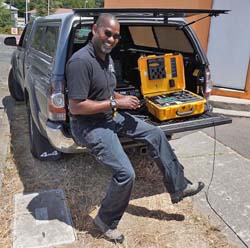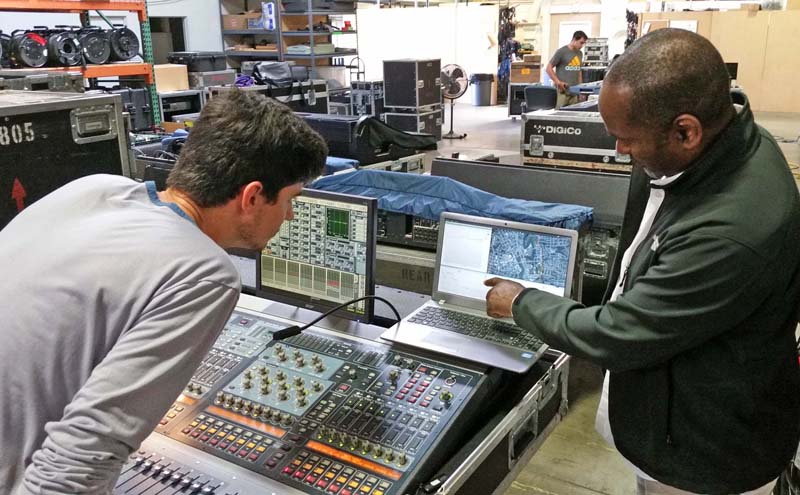Sidney Wilson’s worldview takes in the concept that one man’s music is another’s noise, and then transcends any conventional meanings the phrase may imply.
For him and the Erevu Group, a San Francisco, CA-based firm he founded that’s dedicated to the task of offering creative solutions to noise problems arising at outdoor music venues, harmony is a matter of striking a delicate balance between the needs of fans, artists, promoters, and communities at large.
In practical terms, there are three primary areas Erevu focuses upon as part of its problem solving core services: Real-time noise monitoring, sound system specification, and compliance reporting.
Relying upon an increasingly proprietary analysis platform utilizing hardware and software culled from the pro audio and sound and vibration industries, the company provides guidelines for optimizing venue coverage while simultaneously minimizing the impact on local residents.
Among these guidelines – which are commonly presented to clients in a formal “Code of Practice” document – are detailed recommendations for deploying sound systems, recommended maximum audio levels, loudspeaker types, trim heights, system focus points, and subwoofer configurations.
Getting Started
The Erevu Group came together in a collision of destiny and providence. Wilson, who also serves as operations manager for Hi-Tech Audio in Hayward, CA, was called in to help Jason Alt and George Edwards of nearby Delicate Productions with troublesome noise issues they faced with a Northern California client that owned a winery and hosted outdoor musical events. With an undercurrent of complaining neighbors and litigation swirling around him, Wilson dove into the project without really knowing how deep the water was, and with no real map of how to proceed.
“I only had logic to guide me,” Wilson says of the experience, “so we began by looking at the existing ordinances and made our first measurements based on those ordinances. What we found was that the client was in compliance. As a result the litigation went in an entirely different direction, and we wound up measuring for every event, and helping them design an acoustical shell. Overall it turned into about four and a half years of work, and we created our first Code of Practice document. Over that time we got better and better at doing these measurements, and realized the market potential for our specialized services.”
Ultimately, the winery’s noise-related problems were solved thanks to Wilson’s work and Delicate Productions’ willingness to let him experiment with the process until the desired results were achieved and all parties involved were satisfied. Future revenues generated by the events were saved, and Erevu’s techniques were greatly refined.
As the company continued to evolve, a new generation of clients enlisted its skills. Among this group were the California Roots Music & Art Festival and last year’s First City Festival, both of which were held at the Monterey County Fairgrounds. A site that can easily be classified as one where if anything can go wrong it probably will in terms of acoustical issues, the fairgrounds are bordered by residential areas, the Monterey Pines Golf Course, Monterey Regional Airport, and a mix of commercial strips, churches, and schools.
Add to this the vagaries of being next the ocean and the related microclimate changes it spawns, and one can better appreciate the hotbed of conflicting community issues that Wilson regularly faces underscoring the importance of having a predictable source.
“One of the things we discovered over the years was that despite whatever noise ordinance is in place in a city or county, a venue can be in total compliance and still be considered a nuisance,” he explains. “One neighbor will say the level is fine and then another will be spitting mad and saying they can’t take it. Against this backdrop, it didn’t take us long to determine that a big part of what should determine our best practices is discovering exactly what is disturbing people. Are they complaining about high frequencies, or the low-end? These are major questions you need to answer in order to solve the problem.”
According to Wilson, to a large degree the process of determining exactly what the neighbors are complaining about revolves around whether measurements are being made using A- or C-weighting. Unlike when using A-weighting, audio data measured and viewed with C-weighting allows engineers to see precisely what their relative levels are across the entire frequency spectrum, thereby making individually offending or excessive levels readily apparent.
This, in turn, makes self-correction quick and accurate: Rather than taking the whole bottom-end down if low frequencies are a problem, engineers can simply see that the kick drum is really the issue and fix it. The end result is mixes get significantly better.
















